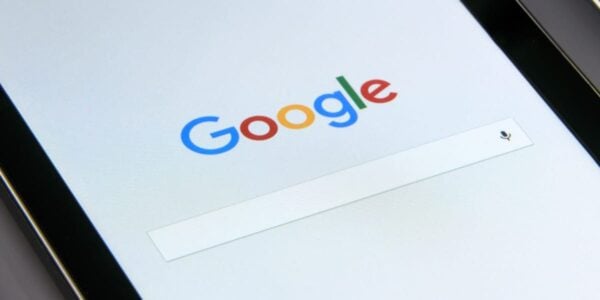Spam marketing is any unwanted, unsolicited message that appears in any marketing channel, including email, social media, phone calls and direct mail. These messages are mostly advertising and scams. The recipient did not request them and perceives them as having extremely low value.
This is the problem with Spam: you gave no permission, implicit or explicit. They shouldn’t have been able to reach you. You have very few ways to stop it.
We prefer to get our marketing on our own terms.
We love advice. We tolerate ads. And we hate spam.
These are really the three types of marketing: content marketing, advertising and spam.
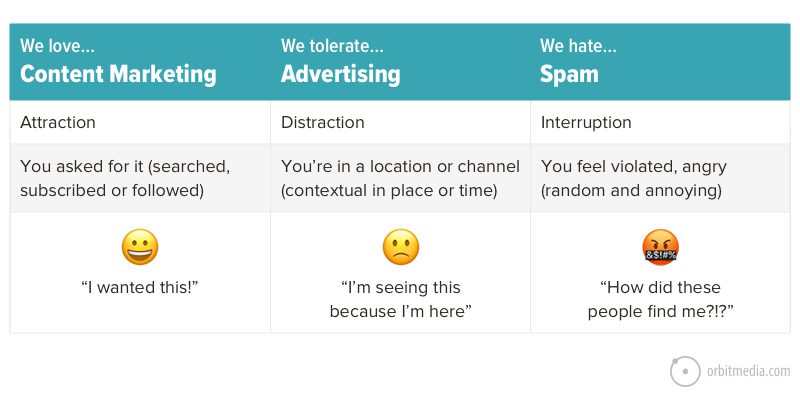
But spam is everywhere. Spammers target everyone in every channel. To measure the size of the spam problem for each channel, we’re collaborating with QuestionPro, repeating a survey from one year ago of 1000+ people from a general population sample in the US.
We will look at the spam trends and ask:
- Which social networks have the most spam?
- How do most people respond to email spam?
- How much text spam are we getting?
- What percentage of our calls are cold calls?
This year, we repeated the survey so we could answer one more question:
- Is spam getting worse?
We’ve also added alternatives from marketing experts. Finally, we’ll close with insights from cognitive neuroscience expert, Carmen Simon, on what “unwanted” marketing really means.
Email spam
First, let’s define it. Email spam is unsolicited commercial email. It’s regulated by the CAN-SPAM Act, which is a fun backronym for “Controlling the Assault of Non-Solicited Pornography and Marketing Act of 2003.” It’s not a long piece of legislation. You can read the law here in under five minutes.
We all get junk email. But how much?
56.5% of all email is spam
That’s according to DataProt’s analysis. But not all of that email spam gets through. Some are caught in filters, sparing the recipient’s inbox.
But according to the survey respondents, more than a third of our email messages are spam. So plenty of junk emails are making it past the filters. And for a lot of us, the majority of our email is garbage. This hasn’t improved over the last year.
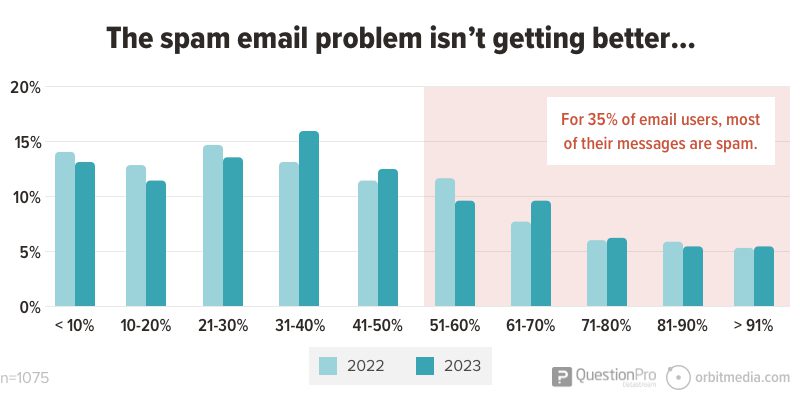
That translates into an average daily volume of 120+ billion spam messages globally per day, costing businesses $20+ billion annually (source). Will spam email ever stop? Not likely.
 |
Mark Schaefer Author of Marketing Rebellion“Perhaps spam is the last frontier of unethical marketing. Most other practices that abuse, interrupt, and intercept consumers have been regulated out of existence. Despite the fact that spam is against the law this regulation is widely ignored because it’s almost impossible to monitor. Spam is one of my Top 5 business irritants!“ |
If survey respondents report less email spam than the email industry reports, maybe our spam filters are working. Let’s take a look:
61% of people use spam filters
A lot of our respondents (48%) use the filter built-in to their inbox provider. Others use free spam filters. 4.1% of our respondents use a paid tool. This is up from 2.7% in 2022. More people are paying for a spam filter.
But, of course, a lot of junk mail still gets through.
Most consumers simply delete or ignore spam, but the majority of recipients are taking action. We are seeing an uptick in people who mark as spam or block and report. More people are blocking and reporting email spammers.
Reporting email spam is how we can all join the battle against spam. Reporting both improves your own filter and makes life harder for spammers. A bad report affects the reputation of the servers spammers use to send email.
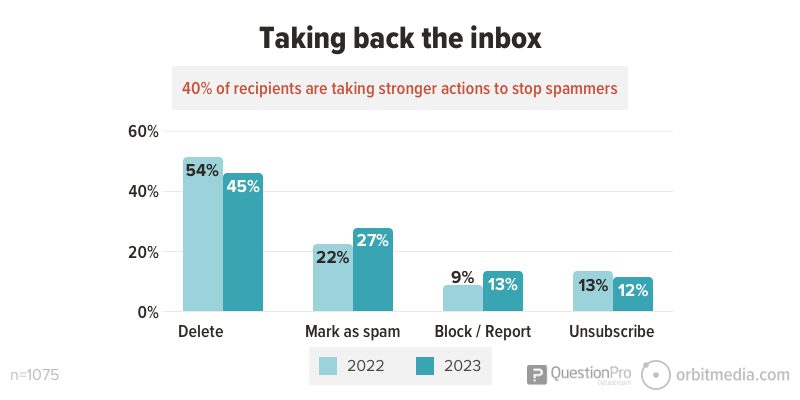
What should a legitimate marketer do?
I asked email marketing pro Justine Jordan how legit marketers can get around spam filters. Her answer gives hope to all non-spammers.
 |
Justine Jordan Postmark“If you’re a ‘legit’ marketer, there won’t be any need to ‘get around’ spam filters. The filters are designed to keep out bad actors who try very hard to pretend like they are legit marketers. So what makes you legit in the eyes of spam filters? You only send email to contacts who have given you permission to contact them, the content in your messages is relevant and valuable to the reader, you make unsubscribing easy and obvious, and you use a reputable sending service that takes accountability for the health of their shared IPs. And if you want bonus points to be an extra legit marketer, you’ve verified that your email authentication methods (like SPF and DKIM) are properly set up. It’s really that easy. It’s long been a myth that spam filters primarily look at content when deciding who makes it to the inbox. Today’s filters are much smarter than that and look at the holistic reputation of a sender when determining how to deliver their email.” |
If you’re wondering why your email marketing is getting caught in a spam filter, Justine recommends this post, which lists 13 possible reasons: Why are my emails going to spam?
Social media spam
Although the term spam was originally used for email, it is everywhere. Of course, social media is a popular platform for spammers and a battleground for marketers, good and bad.
Some social networks have more spam than others.
Facebook and Instagram are the spammiest social networks. Meta properties have the biggest spam problems. They have improved since last year, but they’re still way ahead. Our respondents were far less likely to report seeing spam on LinkedIn.
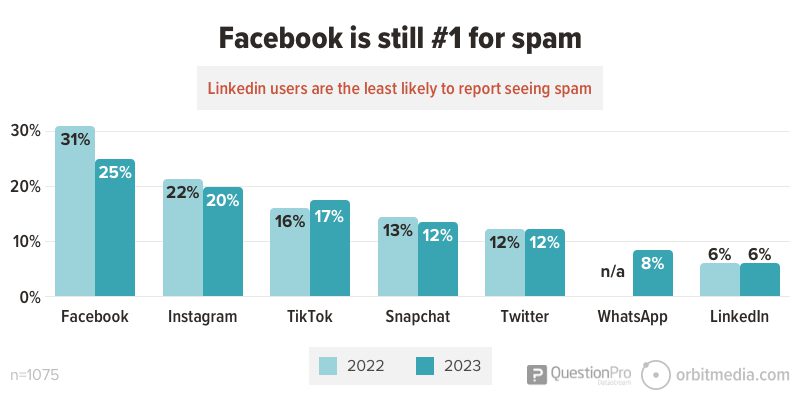
On LinkedIn, users are less likely to be anonymous, and therefore more likely to be concerned with their own reputation. That may explain the difference.
 |
Mike Alton, Agorapulse“A successful social media presence requires consistent levels of activity, including posting, commenting, and responding to comments. As a result, there has been a proliferation of tools designed to meet that need. However, many such tools promise automation and scaling of activity but do so with little regard for authenticity or appropriateness. These tools make it easy for spammers to leave thoughtless comments or, worse, sales pitches, en masse. Legitimate marketers must be wary of using tools that do not offer the capability for personalized, relevant activity, and the networks themselves must do better when it comes to policing and banning abusive tools and accounts.” |
Spam comments are a problem. Spammers are notorious for leaving self-promotional comments on social media. 31% of our respondents see spam comments every day.
Spam direct messages are another problem. Spammers use DMs to send unwanted marketing messages. Most social users get spam messages, and about 20% of our respondents get spam DMs every day.
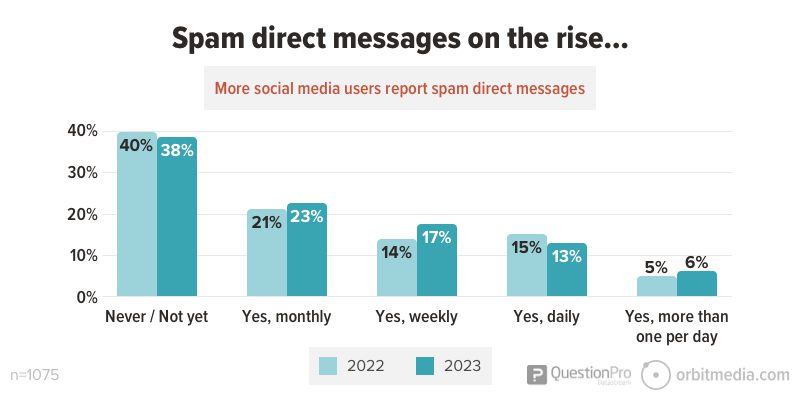
What should a legitimate marketer do?
Social spam, either as comments or DMs, is unnecessary. AJ Wilcox points out that the opportunity to be visible is high, especially on LinkedIn where most users never post.
 |
AJ Wilcox B2Linked“The beautiful part about LinkedIn is that, when you are posting interesting/valuable content, it’s really easy to go viral. The reason for this is that <5% of LinkedIn members post, but 100% of us need a feed full of content when we log in. So LinkedIn specifically looks for posts with comments to place in the feeds of those who aren’t even following you. When you put value out into the world, you’re rewarded for it with others outside your network getting to know you. No need to send spammy InMails or connection requests that already have you feeling like a used-car salesman. Just share what’s interesting and helpful and the attention comes to you!“ |
Text message spam
To stay focused, I do everything possible to minimize distractions. That means turning off almost all the notifications on my phone. But there is one notification I leave on: my text messages. For years, it was strictly for friends and family, and the messages were all personal or important.
But no more. Spam has come to text messages.
Text messaging, also known as SMS (short messaging service), is a standard messaging protocol built into all of our phones. It’s actually the most popular feature of our phones, used by 80% of phone subscribers in the US. So we’ve all got it. And for most of us, the spammers have our numbers.
So here’s the size of the text messaging spam problem today. We assume this will grow over time.
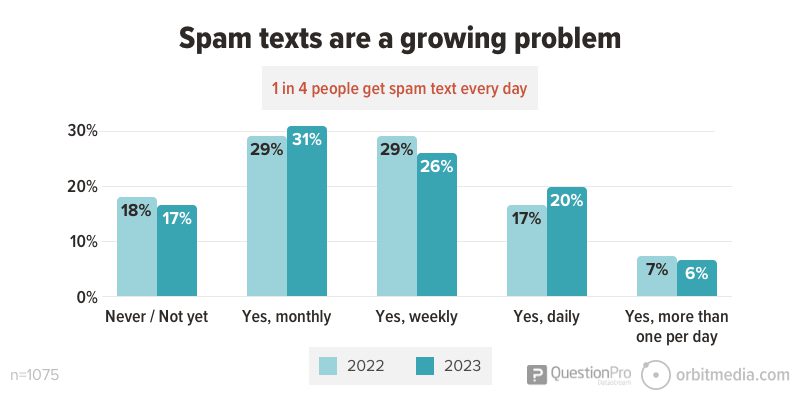
And because it’s an open standard protocol, there isn’t a tech company standing in between us and the spammers to help filter.
We are defenseless.
So how can you stop text spam? Your only option is to “block unknown senders” from inside your spam message settings, which basically opts you out of all texts from everyone except those in our address book, turning your contacts into a white list.
It’s an extreme response and it could cause big problems. What if someone not in your address book sends an important text? “Hey, I’m your neighbor from across the street. Your garage is on fire.”
Text spam is insidious for at least two reasons: SMS technology makes the sender anonymous (anyone can send a text from any number) and is within a context that is generally trusted (most texts are from close personal relations or businesses we work with).
This dangerous combo makes text spam ripe for fraud, identity theft and financial crime. Many of you will have seen this on your phones. 29% of respondents received texts that ask for personal information or included a phishing link.
Here is an example of text spam that is literally criminal. It is an attempt to impersonate a bank and get me, the recipient, to share personal information. Notice the strange URL and the lack of security certificate in the link (http:// rather than https://)

This is a picture of a crime scene. They’re trying to break into my accounts or set up fake accounts in my name. Many people get messages like this every day. Depending on your phone plan, you may actually pay to get these scams.
What should a legitimate marketer do?
We had to reach out for a pro for this answer. Stephanie Griffith’s response to our request for a quote is like a mini-starter class for SMS marketing. Follow her at @QueenDTC to get more of her insights.
 |
Stephanie Griffith Founder emailpreview“Well-intentioned SMS marketers are starting at a disadvantage thanks to spammy political campaigns and other unwanted texts.Hope isn’t lost though, and there are strategic ways to build trust with your audience. Reinforce the legitimacy of your brand by introducing yourself with a contact card, giving subscribers an easy way to save your information. This will ensure that your future messages are recognizable, and some devices (like iOS) will give priority to delivering messages that are tied to saved contacts. Unknown numbers feel inherently unfamiliar, but contact cards help build a trusted relationship between the sender and the recipient. The best texts feel friendly, intimate, and personal, as if they are coming from a friend or trusted source. You should embrace the short but conversational nature of the channel and craft your messaging accordingly. Ask engaging questions, and be prepared to respond! Be respectful of quiet hours and when choosing to time your messages. While there are legal reasons to follow this guidance, it’s also common sense. Would you stay engaged with a brand that woke you up in the middle of the night to announce the last chance to shop their sale? Lastly, invest in a short code. These 5- to 6-digit phone numbers are the SMS gold standard and the hallmark of a respected sender. Shortcodes go through a rigorous approval process, ensuring they are only given to those with proper consent and messaging practices. You are also given higher priority as a sender and greater deliverability/messaging throughput when sending from a short code, which can be critical when communicating with a sizable audience.” |
Cold calls: Phone spam
About an hour ago, my phone rang. It was a local area code, so I answered. Maybe it’s important? Someone I know? …no, it was a financial planner, pitching me his services.
Cold calls from telemarketers are part of daily life for many of us. Almost 90% of our respondents reported getting telemarketing calls. Nearly 40% of people get telemarketing calls every single day.
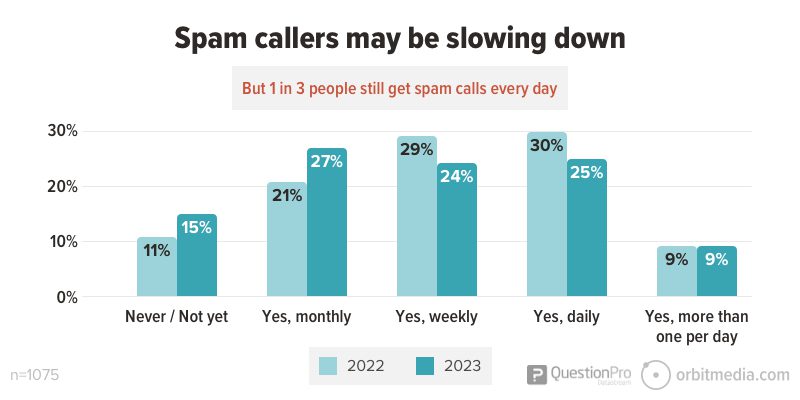
There are two ways to fight back: with laws and with technology. Neither is perfect.
To add your phone number to the National Do Not Call Registry (or to verify that you have already done so) visit www.donotcall.gov. They’ll send you an email to confirm. If you don’t see it, check your spam filter.
The other way to mitigate telemarketers is with a call blocker, either built into your phone or using an installed app. 78% of our survey respondents use a call blocker to stop telemarketing calls. But of course, enough get through to make you distrust your phone, every time it rings.
What do you do when the telemarketer calls?
The majority of our respondents simply don’t answer the phone. Just like every other form of spam, the most common response is to ignore it. But 1 in 5 pick up the phone, and 7% of respondents report being rude to telemarketers. Although I don’t recommend being uncivil in any context, I do understand. The telemarketer was rude first by interrupting.
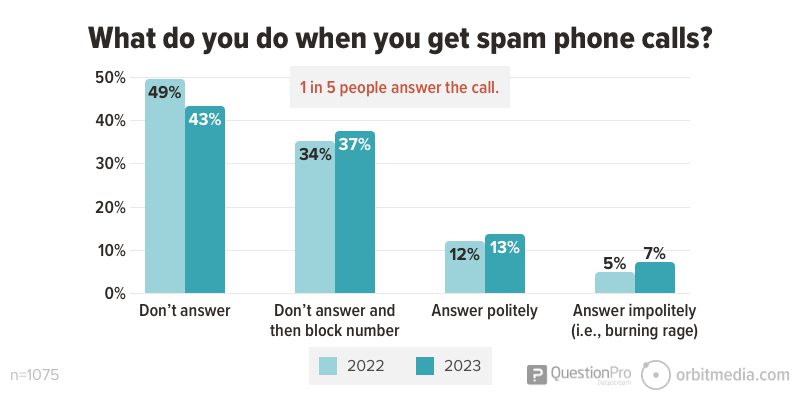
Will all this spam eventually stop?
No. Because spam still works. Not well, but it works well enough (and the costs are low enough) that spammers will continue to bombard us through every available channel.
Of course, it’s harmful to brands, personal and corporate, because it erodes trust.
 |
Jeannie Walters Experience Investigators“Building trust with customers is the same as building trust in any relationship. It takes time. Trust is built by meeting their needs, respecting their time, and being there when they need you. Spam is built on ignoring the basics of that trust-building. These messages are disrespectful of their needs, and their time, and are intrusive instead of supportive. Trust might take time to build, but it just takes one bad experience to break. Spam messaging is an excellent way to destroy trust with customers and future customers alike. I hope marketers get the message!“ |
In our final question, we try to understand the effectiveness of spam by asking people if they had ever bought a product or hired a service from a spam message. In other words, have you received spam that worked on you?
Their answers complete the story. 19% of respondents had responded positively to spam …and profitably for the spammer.
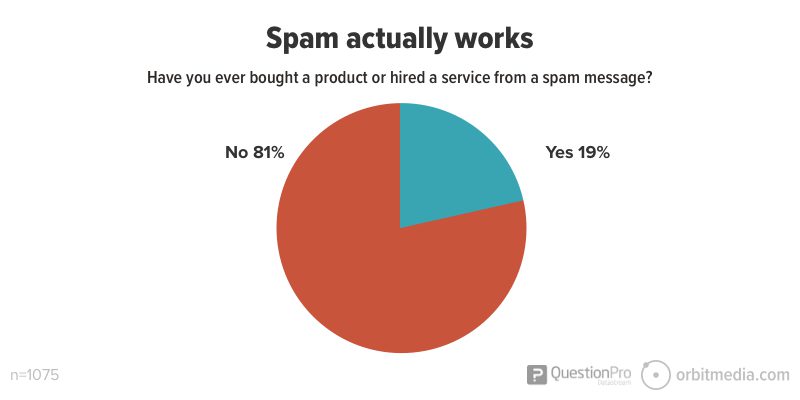
This is why spam isn’t going to stop. It’s because spam continues to work. But that doesn’t means that marketers should send unwanted and unsolicited messages. We reached out to cognitive neuroscientist, Carmen Simon, to learn how to increase the desire for these messages.
 |
Carmen Simon, Chief Science Officer, Corporate Visions“In this context, we are defining spam as unwanted, unsolicited marketing. What does the brain need to turn something from unwanted to wanted and from unsolicited to solicited? Let’s start with the notion of unwanted. One of the newer findings in neuroscience is the fact that wanting and liking are processed differently in the brain. People often use those terms interchangeably but they are different. It’s possible to like something but not want it and vice versa. This is important to note because it may ease some pressure off marketers: your customers do not always have to like what you send them (it’s nice when they do). They just have to want it. So, what triggers wanting? Reward-related cues (think about the smell of someone barbecuing chicken when you’re hungry) or vivid imagery about the reward (think about an ad with steaming chicken, when you can sense the texture of the skin and can see the steam flowing away). In light of this information, any marketer that creates messages and campaigns can ask these questions:
Now, let’s consider the other keyword: unsolicited. I imagine that one of the marketers’ ideals would be a state where people solicit information. What triggers that from a brain science perspective? There are many things that prompt us to ask for information, but one is the desire to use innovative tools that promise a reward. Some examples of reward include the promise of convenience, fun, discovery, getting the absolute best in a context, or time savings. So, look critically at your own content or products or services and ask: how innovative are the things I am offering? Do they respond to these motivational drivers? Do they have so much strength that people want to find out details? The more you study consumer behavior and psychology, the closer you will get to being asked to send information (by a more qualified lead, too) instead of sending broad messages en masse. |
We appreciate you, ethical marketers!
If you refrain from spamming, we’d like to say thank you, on behalf of all of the people you didn’t annoy today.
Also, thank you, Carmen, and all of our contributors. And a special thanks to QuestionPro for making this spam statistics study possible. You can find more research on the QuestionPro blog.
Found this interesting? Share with a fellow marketer!
Annoyed by a spammer? Send this link to them and suggest they try content marketing.



